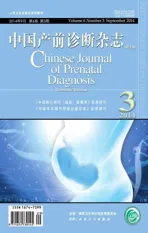“胎盘血管阻力的新型评分方法”点评
2014-01-21杨萌戴晴李建初姜玉新
杨萌 戴晴 李建初 姜玉新
(北京协和医院超声医学科,北京 100730)
“胎盘血管阻力的新型评分方法”点评
杨萌 戴晴 李建初 姜玉新
(北京协和医院超声医学科,北京 100730)
1 原文摘要
BackgroundUmbilical artery Doppler velocimetry is a routine method for fetal surveillance in high-risk pregnancy.Uterine artery Doppler seems to give comparable information,but it can be difficult to interpret as there are two arteries,which might show notching and/or increased pulsatility index(PI)as signs of increased vascular impedance.Combining the information on vascular resistance on both sides in a new score might simplify and improve evaluation of placental circulation.
MethodsUterine and umbilical artery Doppler velocimetry was evaluated in 633 highrisk pregnancies.The managing clinician was informed only about the umbilical artery flow.The umbilical artery flow spectrum was semiquantitatively divided into four blood flow classes(BFC),expressing signs of increasing vascular resistance.The uterine artery Doppler flow spectrum was divided into five uterine artery scores(UAS),taking into account presence/absence of notching and/or increase in PI.By adding UAS to BFC,a new placental score(PLS)was constructed with values ranging from 0 to 7,indicating general placental vascular resistance.The scores were related to three outcome variables:smallfor-gestational age(SGA),premature delivery(<37 weeks),and cesarean section.
ResultsAll three score systems showed a significant relationship between signs of increasing vascular resistance and outcome.The new PLS showed the best association to adverse outcomes,with optimal cut-off at values exceeding score 3.
ConclusionDoppler velocimetry on both sides of the placenta showed a strong relationship to an adverse outcome of pregnancy.The new PLS showed a better relationship to adverse perinatal outcome than the BFC and the UAS.The PLS can simplify evaluation of uteroplacental and fetoplacental Doppler velocimetry.
2 论文核心内容及点评
该文章2003年9月发表于《Acta Obstet Gynecol Scand》杂志。脐动脉多普勒速度参数检查是高风险妊娠胎儿评估的常规方法。在该研究中,作者在对脐动脉及子宫动脉血流频谱进行分级和评分的基础上,建立了新的胎盘评分方法,并在633例高危妊娠的临床病例中对该评分方法与血管阻力及不良预后的相关性进行验证研究。主要内容如下:
这是一项临床实验性研究。作者对633例妊娠高风险孕妇(包括妊高征等)进行彩色多普勒超声脐带血流动力学参数检查及随诊。将脐动脉血流频谱按照波形特点半定量分为4类(blood flow classes,BFC),可提示血管阻力的升高;根据PI升高和(或)出现舒张早期切迹,将子宫动脉多普血流频谱评分(uterine artery scores,UAS)分为5级。将BFC与UAS相加,获得一种新的胎盘评分(placental score,PLS)方法(0~7分),提示胎盘的血管阻力状态。进而将BFC、UAS及PLS 3种评分与胎儿发育小于孕周、早产(<37周)、剖宫产这3种妊娠结局变量进行相关性分析,结果提示上述3种评分方法均与血管阻力增高及妊娠预后有较好的相关性。其中新的胎盘评分PLS与妊娠不良预后的相关性最好,其预测阈值为PLS>3分。由此作者认为胎盘双侧的多普勒速度参数与妊娠不良预后具有较强的相关性,新胎盘评分PLS与胎儿围产期预后的相关性优于BFC和UAS,并能简化现有的子宫-胎盘和胎儿-胎盘多普勒血流参数评估方法。
现有研究结果证实,对于胎儿生长受限及其他高危妊娠胎儿的评估,除了脐动脉多普勒速度参数之外,测量胎盘双侧的血管阻力也有助于提高诊断效力,研究发现子宫动脉阻力的升高可能较脐动脉更为敏感和显著,因此子宫动脉多普勒参数也是高危妊娠胎儿的有效评估指标。本研究不仅在较大样本量(633例)的高危妊娠病例中验证了脐动脉频谱半定量分级(UAS)对妊娠预后不良的预测价值,也证实了子宫动脉血流评分(BFC)的临床应用价值。本研究的主要创新点在于进一步建立了一种结合多种血流评估参数的新型胎盘血流评分方法PLS,并通过大样本量病例验证了其对于胎盘血管阻力升高及妊娠预后不良具有较传统血管阻力评估方法更好的预测价值。该研究结果为临床评价胎盘整体血流状态提供了新的量化评估方法,有助于简化并提高多普勒超声对高危妊娠胎儿的监测、随诊和预后评估能力。
10.13470/j.cnki.cjpd.2014.03.017
